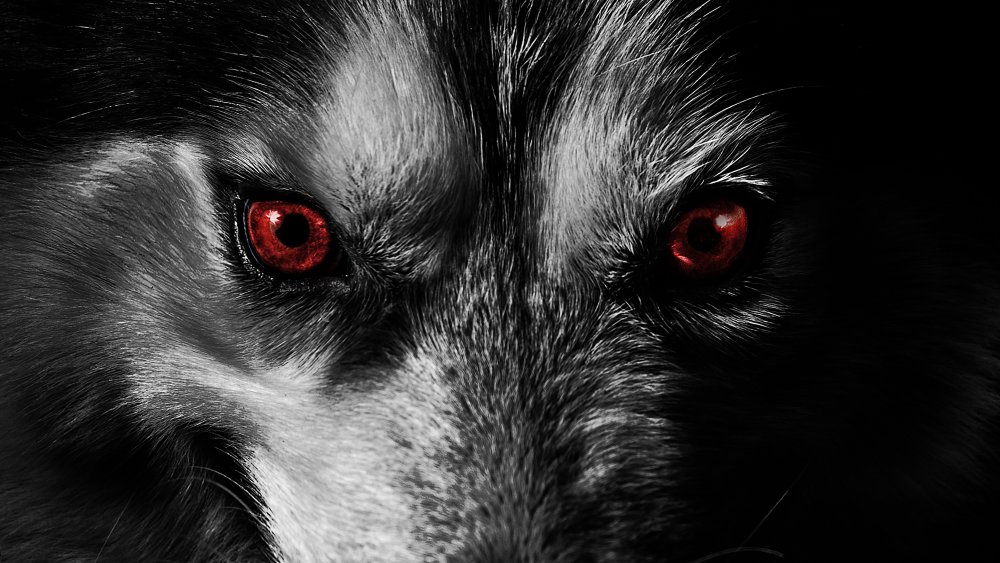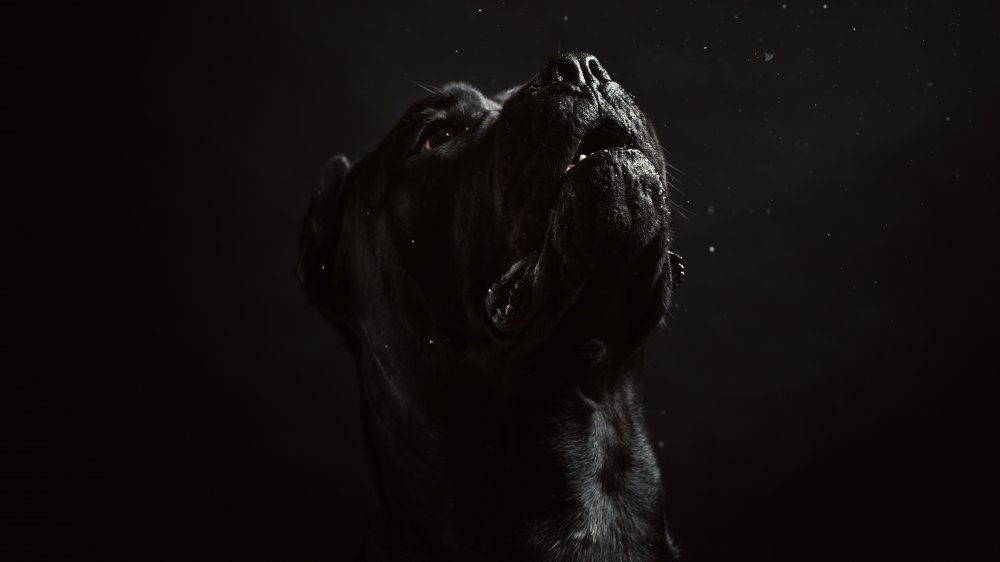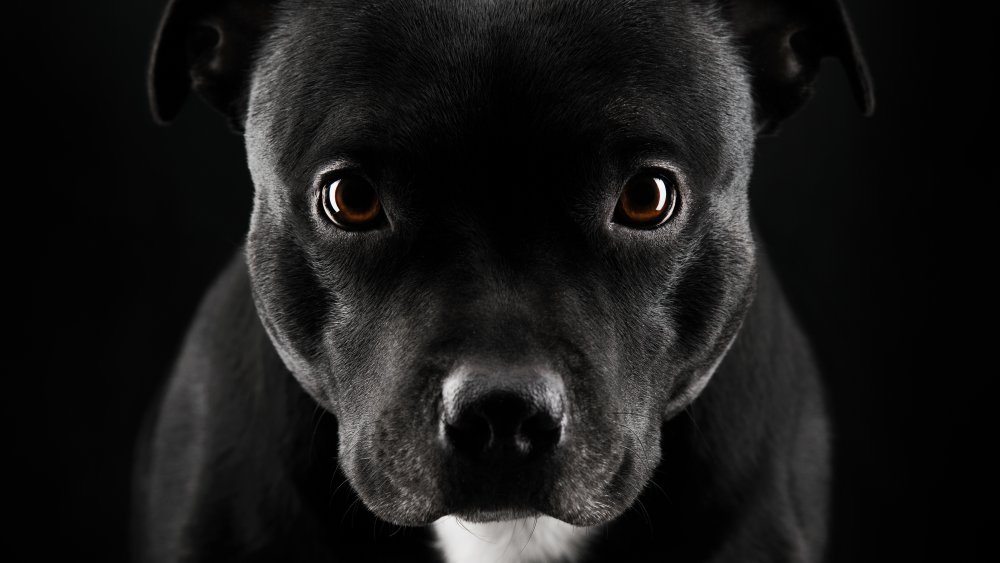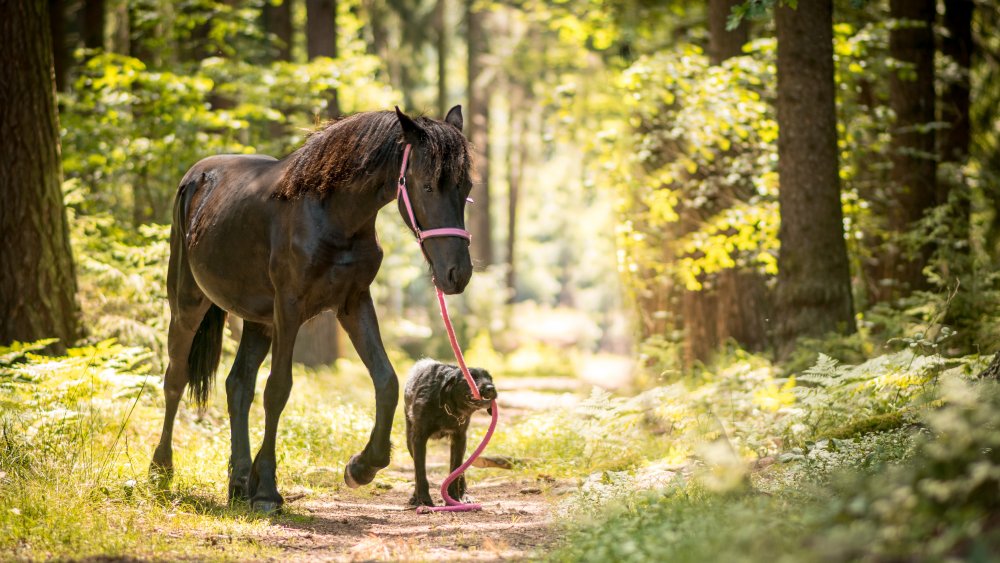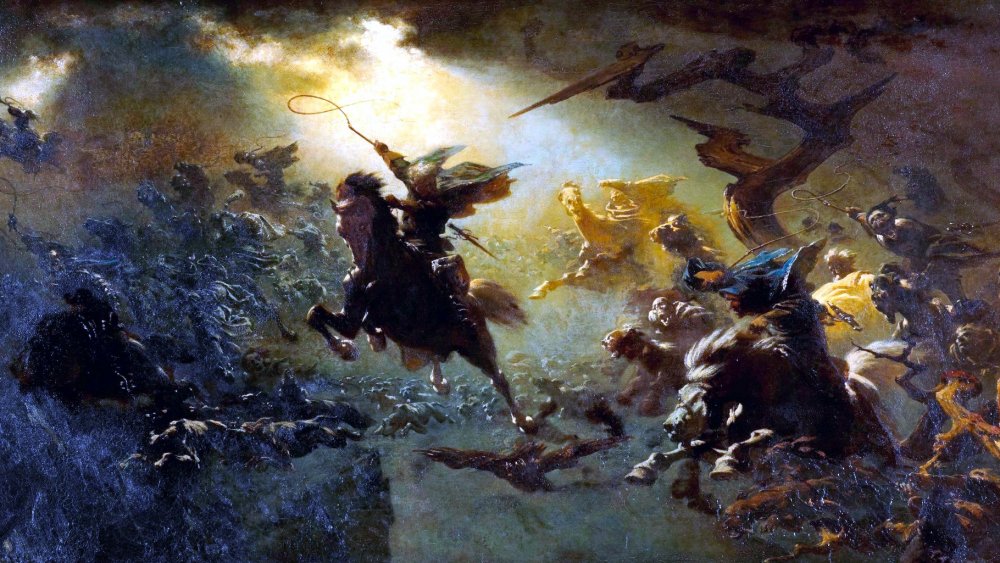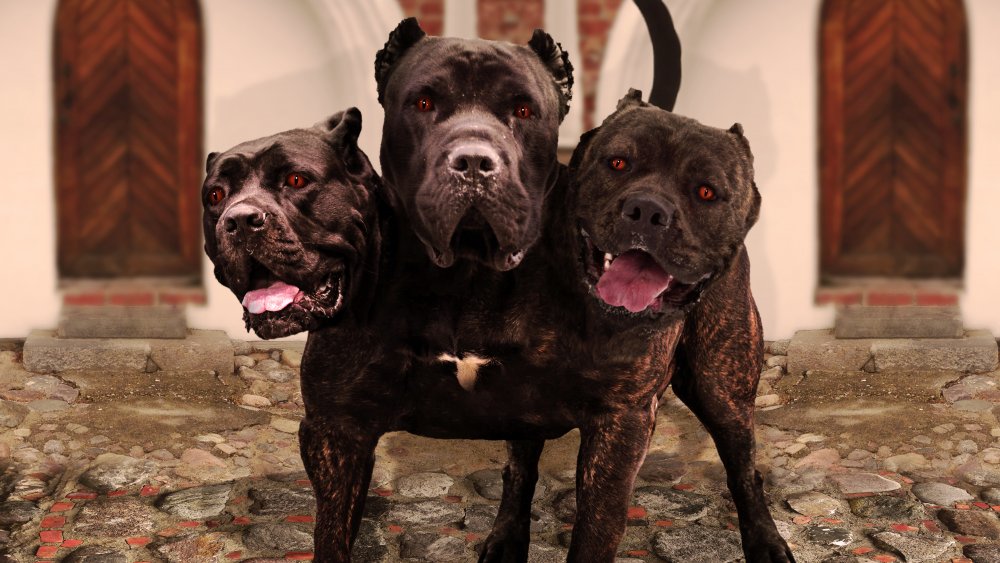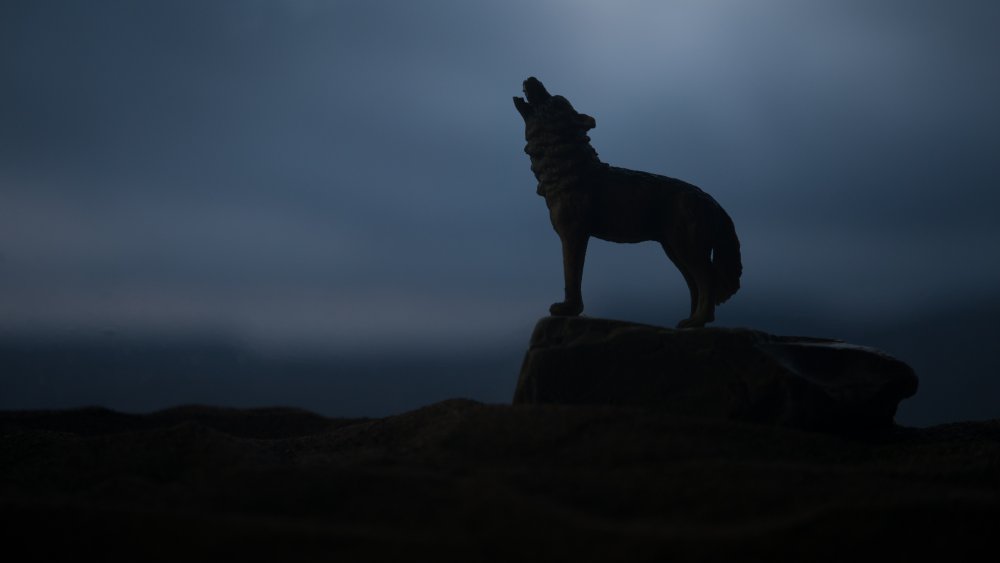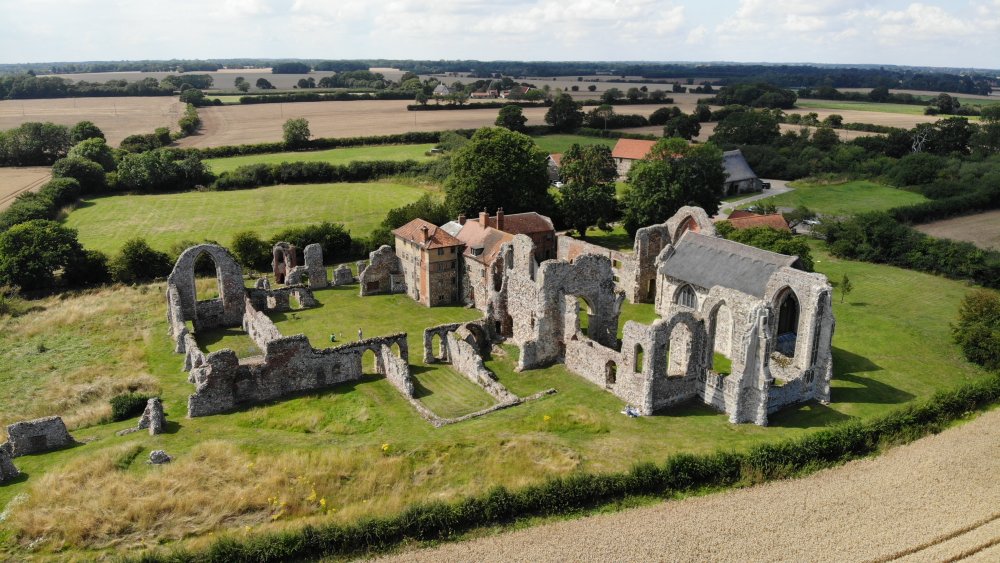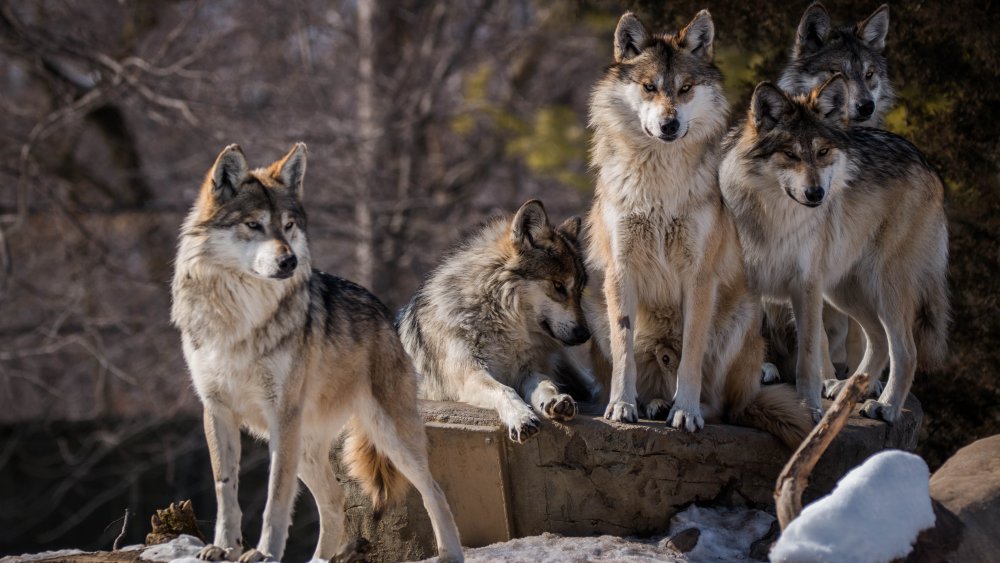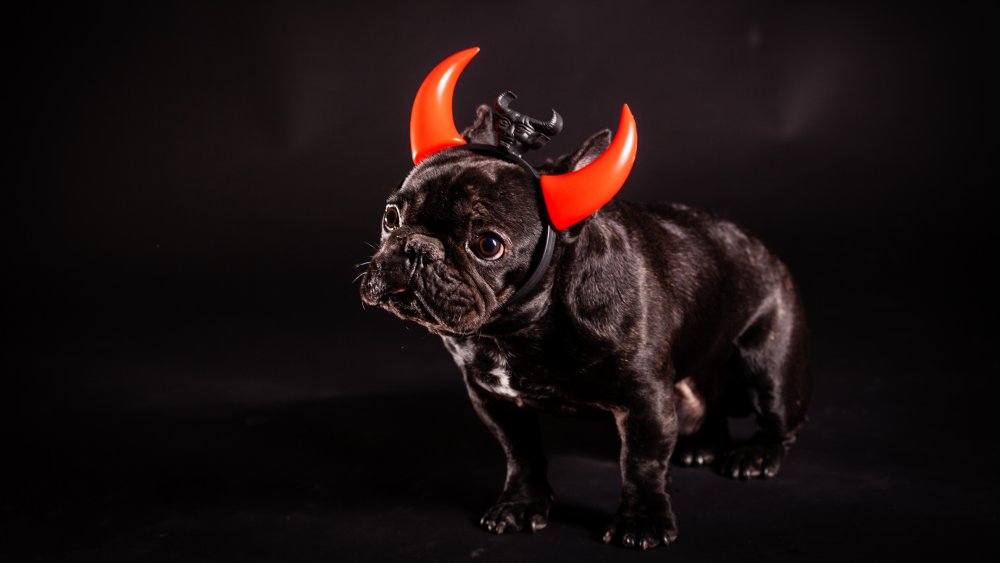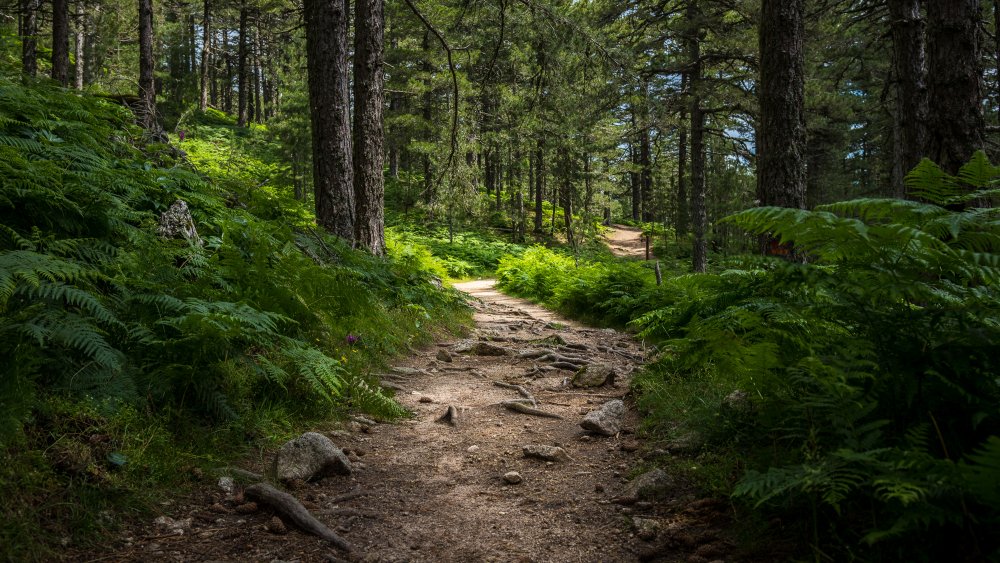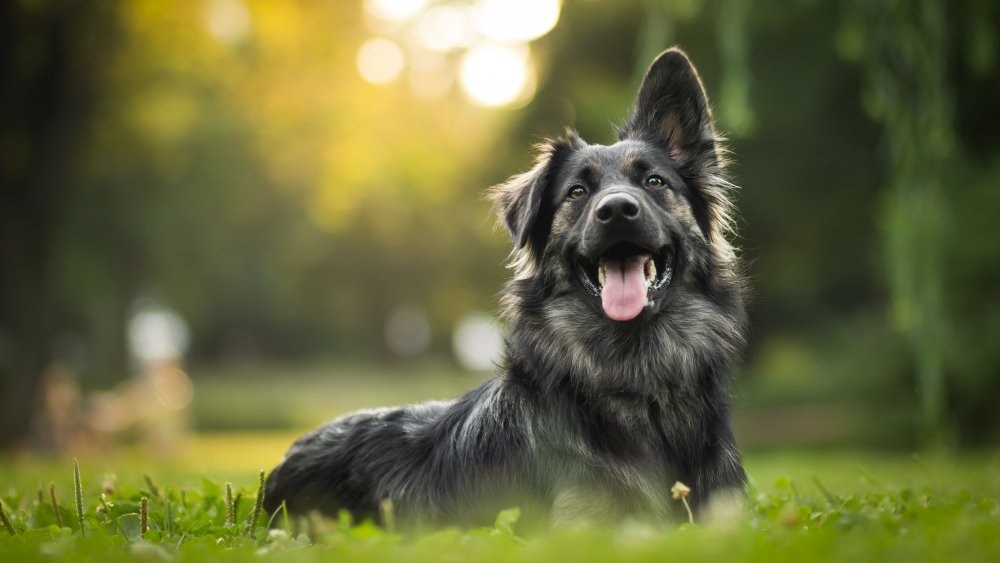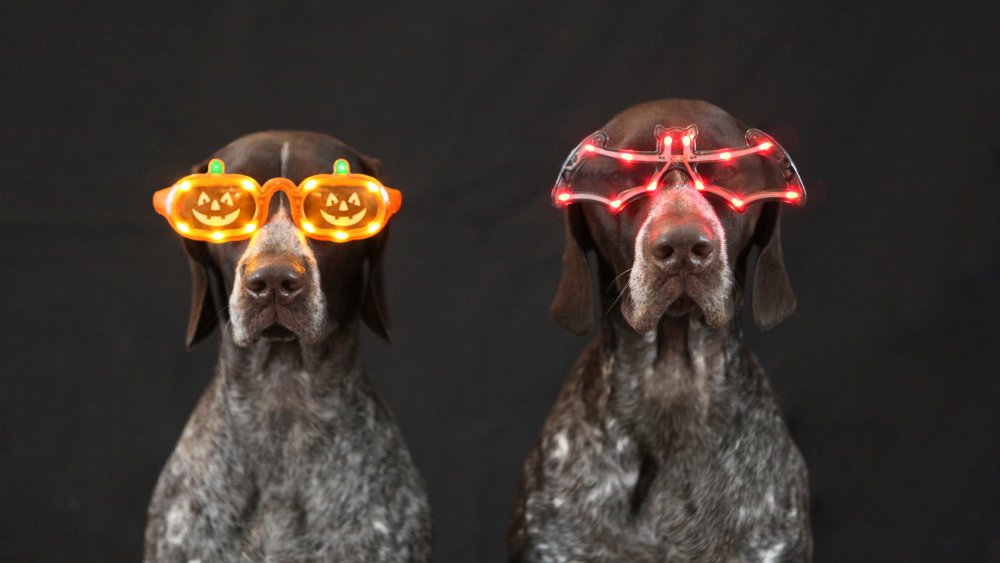The Legend Of Hellhounds Explained
Dogs have been man's best friends for a long, long time — according to the Smithsonian, they've lived alongside us for so long that the details on how that partnership started have gotten a little murky. That's too bad — they quote one anthropologist as saying, "The domestication of dogs was one of the most extraordinary events in human history."
For as long as we've had dogs by our side, we've been more than a little suspicious of dogs of the not-so-nice variety. Wolves may only want to be left alone, but mankind has long told tales of another kind of dog: the black-furred, red-eyed beast that lurks in the night, watching and waiting. Yikes.
We've even given canine companions to our deities... good and bad. And it's sort of fitting... many of these otherworldly beasts are tasked with guiding our souls to the afterlife, or guarding the gates to make sure no trespasser gets in... or restless soul escapes. Who are these hellhounds... and how did they evolve from our most trusted companions?
Hellhounds and black dogs
"Hellhounds" is actually a pretty broad term that covers what's two distinct groups of dogs. First are the literal hellhounds, beasts that Britannica says have traditionally cropped up in the world's mythology, usually standing guard at the underworld. Those dogs are definitely something special: they're otherworldly and divine. But there's something else that wanders our world with us, a different kind of hellhound that's no less terrifying, but slightly more real.
Folklore is rich with tales of spectral hellhounds that haunt our world, and according to Kiersten Carr of Utah State University, the black dog is particularly popular in the tales of the British countryside. Many areas — like Lincolnshire, East Anglia, Devonshire, and Somerset — have their own black dog, and a set of legends that have grown up around them.
The hellhounds of folklore are no less terrifying than those of mythology: their appearance is almost always described as terrifying and malevolent, they're often associated with cemeteries, graveyards, or places where executions or particularly violent murders have taken place, and whenever they appear, they're usually said to be an omen of death.
Not all black dogs are bad
So, you're wandering the British countryside, and suddenly, you're aware of a massive black hellhound following you. Should you be scared? Probably... but maybe not, says Kiersten Carr of Utah State University. Not all spectral black dogs of folklore are bad, and some might even show up knowing you're in need.
Take the tale of a "Mr. Wharton," who told a story about a friend named Johnnie. Johnnie was walking through the English forests, on his way to visit a friend, when a massive black dog suddenly appeared at his side. The dog walked with him to his friend's home, waited outside, and rejoined him when he left. He escorted him back out of the woods and vanished at the treeline. Years later, two prisoners at York Gaol confessed that they'd seen him, and had every intention of killing and robbing Johnnie that night. But? They were deterred by the presence of the black dog.
Other stories of these benevolent hellhounds are very similar: they usually appear to escort someone to their destination, and eventually, that person finds out they were being targeted by someone for something horrible, only to be saved by the presence of the dogs. The dogs of some areas — like Lincolnshire County — inevitably act as protectors, proving that even hellhounds can be good boys!
Hellhound sightings go back to at least 1127
The earliest record of the sighting of a hellhound goes all the way back to 1127, and it's buried in a fascinating document called The Anglo-Saxon Chronicle. The preface of the 1914 version describes it as "a chronological record of important events," starting with the year AD 1 — the reign of Octavian and the birth of Christ.
Fast forward a bit to 1127, and along with records of a meeting between England's King Henry and Scotland's King David, there's mention of a Sunday in Peterborough. People began reporting seeing a group of hunters, but they weren't exactly earthly hunters: "These hunters were black, and large, and loathly, and their hounds were all black, with wide eyes, and ugly, and they rode on black horses and on black bucks. This was seen in the very deer-park of the town of Peterborough, and in all the woods from the same town to Stamford; and the monks heard the blasts of the horns which they blew in the night."
Is that the first sighting of a hellhound? It's impossible to tell just how long the stories have been circulating around Britain, but according to Paranormal Case Files of Great Britain, it's the earliest record we have. Whatever was seen that night, it was important — and frightening — enough to list among the annals of kings and queens.
Hellhounds and The Wild Hunt
Among the different kinds of hellhounds are those that run with the Wild Hunt (via the BBC)... and there's so many different cultures that have similar stories of hunts that, well, it's enough to make even the most cynical people start to question. According to Norse Mythology, the Wild Hunt motif spans the ancient to the modern world, particularly in northern Europe. It's alternately called the Terrifying Ride, the Raging Host, or Asgardreia (via the Orkney Jar), and you don't want to be around to see it. Anyone who catches a glimpse of them is likely to get swept up by a rider and, if they're fortunate, dropped off miles away.
The leaders of the hunt vary, too — in some areas, it's Odin, while in others it's Perchta, or Herne the Hunter, and in the Middle Ages, it was even said the hunt was led by King Arthur or Charlemagne. In Wales, the Hunt was led by Gwyn ap Nudd — the Lord of the Dead — and his hellhounds were a little different: completely white save their blood-red ears, and their ride was said to herald imminent doom.
For all the variations on the tale, there's some things that are similar across most cultures. The hunters usually rode in mid-winter, on the coldest, darkest nights of the year, running through forests and storms. They're always in the company of their horses and their hellhounds, and they're always seen as walking between the living world and the dead.
Guarding the gates to hell
What happens after we die is one of the great mysteries of the world, and cultures across the world have tried explaining just where we go when we leave the land of the living. A surprising number of them have hellhounds that either act as spirit guides to take souls to their final resting place, or as guards of the underworld.
The most famous is probably Cerberus, the three-headed hound of Hades (via Greek Mythology). He was one of the monstrous children of Echidna and Typhon (and a sibling of the hydra and the chimaera), and according to some myths, those three heads may have just been a more convenient way to depict him in art — Hesiod claimed he had 50 heads, while Pindar said he had 100.
Cerberus isn't alone, though. The Ancient Egyptian pantheon had Wepwawet (via Ancient Egypt Online), a wolf god whose name means "the opener of ways." It's believed that he was the one who guided souls on their path through the afterlife, and was eventually absorbed into Anubis and Osiris. And the Aztecs had Xolotl, a dog (or dog-headed) god who carried both the sun and the human soul (via American Anthropologist). Then there's Garmr, the Viking Age dog Norse Mythology says has been connected to the hound of Hel. He's also been linked to another massive canine — Fenrir — and while that link's uncertain, we do know he and the underworld were invariably connected.
Black Shuck, the most famous English hellhound
Many towns and counties across Britain have their own hellhounds, but the most famous is possibly Black Shuck. Britannica says he's a barguest, which is a monstrous dog that only comes out at night. In some stories, he's particularly easy to recognize because of his single eye.
Atlas Obscura says Black Shuck was said to live in the area around Leiston Abbey, and sightings of him go back around 500 years. The most famous story is that on August 4, 1577, Black Shuck broke down the doors of two churches — Holy Trinity Church in Blythburgh and St. Mary's Church in Bungay — and ran through the congregations gathered there. During the first attack — which led to the collapse of the church steeple — he reportedly killed a man and a boy. In the second attack, he made a beeline through the crowd, heading for two people who knelt in prayer. They were dead before they knew what hit them.
And sightings have continued for a long, long time. According to the Eastern Daily Press, a man was driving a cart along a lane in Norfolk... in 1893. A massive black dog — who the driver's companion later identified as Black Shuck — stepped out into the road. The driver refused to swerve for him and when the cart collided with the dog, it burst into flames. The driver was dead within days, and the dog was never seen again.
What about those claims that archaeologists found a hellhound's remains?
In 2014, Black Shuck was in headlines again: The Daily Mail proclaimed: "Is this the skeleton of legendary devil dog Black Shuck who terrorized 16th century East Anglia? Folklore tells of SEVEN FOOT hell hound with flaming eyes." The article went on to claim that archaeologists working at Leiston Abbey (pictured) had uncovered the remains of a seven-foot-long dog, which appeared to have been buried at the same time Black Shuck was terrorizing East Anglia. So, was there a massive torch-and-pitchfork party that ended with a massive success?
Not... exactly. The archaeologists at DigVentures were horrified when they found their discovery reported in The Daily Mail, with head archaeologist Brendon Wilkins writing of the article: "How on earth did this happen, how could we contain it, and was this the end of any shred of archaeological credibility I would ever have?"
Fortunately, it wasn't, and while it wasn't Black Shuck, it was pretty cool. What they found was the skeleton of a dog that stood about 2.5 feet at the shoulder — about the side of a Great Dane. The bones indicated he had been an elderly good boy and had been buried with care. He wasn't a hellhound, but a treasured companion. Details? They're important.
Some hellhounds hunted in packs
The folklore of the British countryside and ancient mythology might be filled with tales of solitary specters and lone dogs, but there's the occasional tale of packs of hellhounds, too. There's a few different versions of similar tales, but let's take the story of a priest named Dando, retold in Popular Romances of the West of England. He was popular and well-liked... mostly because he forgave pretty much anyone any of their sins. Why? Because he liked to sin, too. He also loved to hunt and was well-known to destroy the grounds of idyllic estates and kill indiscriminately.
Not surprisingly, it wasn't long before he caught the attention of the devil, who showed up on one of his Sunday hunts and took some of the game he'd killed. The priest shouted that the game was his — and if the devil took them, he promised, "I'll go to hell after them, but I'll get them from thee!" Satan responded: "So thou shalt," before picking him up and setting him on his horse. It's said that every Sunday morning, Dando rides the same countryside again — and locals can tell, because they can hear the hellhounds baying as they chase.
Sometimes, those locals claimed to have been set upon by packs of hellhounds, but as retold in Folk Lore of a Cornish Village, there was one way to keep them at bay: kneel in prayer, and the hunter will call them off in search of other prey.
Beware the Barguest
The Barguest — or Barghest — is another hellhound that roams the British countryside, this time, in the north. According to Britannica, seeing the Barguest was a very ill omen, indeed: anyone who got the slightest glimpse of the monstrous dog had just months to live, while anyone who got a good, long look would be dead within days.
Different areas had different names for their Barguest, and some had distinct, terrible characteristics. The Manchester Barguest, for example, had no head. In Lancashire, they called their barguest Skriker, and it was usually said his feet pointed backwards and locals always knew he was on the prowl by his terrifying howl. Others were said to be amphibious, because being chased by a hellhound on land isn't terrifying enough.
But, there's good news: the barguest isn't all bad. According to Whitby Online, Whitby's own barguest is often credited with being a major inspiration to Bram Stoker, and the dogs of Dracula. Then, you can hop over to Yorkshire Dales, where the barguest reported to haunt Trollers Gill in Lower Wharfedale was likely one of the inspirations for Sir Arthur Conan Doyle's Hound of the Baskervilles.
Traveling in groups isn't going to help you
Think you're going to avoid the local hellhound by travelling in a group? Sorry, legend says that's absolutely not going to work.
According to the Encyclopedia of Beasts and Monsters in Myth, Legend, and Folklore, even groups of travelers walking at night aren't safe from the hellhound — it's entirely possible that one person in a group will see it, while the others simply won't.
There is, however, one way to keep yourself safe, and that's to walk with a descendant of Ean MacEndroe. Specific? Absolutely. MacEndroe lived along Loch Ewe in Scotland, and according to Magickal, Mystical Creatures, legend says that he once came across a fairy tangled in a bramble bush. He stopped and freed her, and as thanks, she granted him and his descendants eternal protection from the black dog. So, while walking with any old buddy from the pub isn't going to help you... well, just ask if he's managed to trace his family back to Scotland, and if there's a MacEndroe anywhere in that family tree. In that case, you don't have anything to worry about.
Why black dogs?
So, how did man's best friend become corrupted into the hellhound? And why are they (almost) always black?
Kiersten Carr of Utah State University says there's a few fascinating things at work here. First, the color. In the Christian mythos, black has typically been equated with evil, the devil, and the bowels of the earth — in other words, the same hell these dogs are destined to guard. But black is also the color of mourning, funerals, and death... so there's that connection, too.
And as for why our collective consciousness created evil dogs in the first place, it's possible it has something to do with their reputation as scavengers. While hellhounds are associated with death, executions, murder, and graveyards, real flesh-and-blood dogs have been recorded scavenging for anything they can find to eat — and yes, in extreme cases, that means dead bodies. As far back as Ancient Egypt, they were associated with graveyards, but there's a bit more to it. When we see animals feeding on the remains of the dead, we know there's something inherently wrong about the death. The deceased wasn't cared for, and that suggests an unnatural end. From there, it's just a short hop, skip, and a jump to the supernatural, and man's best friend became man's worst nightmare.
So, what are people really seeing?
So many places have their versions of the hellhound, there's got to be something to it... right? Probably, says Wired. The answer to "why dogs" is probably pretty simple: they've been around us for a long time, and there are few animals that are as culturally as important to us — so when we see a mysterious animal, it's not entirely surprising we think it's a dog.
Next? Many of the stories of seeing a black dog involved waking up from a sound sleep and seeing one at the foot of the bed. That's likely a byproduct of sleep paralysis, which happens when your brain and your body get out of sync during the process of waking. Your mind's awake but you can't move, and some people have been known to see spectral forms.
And what about the stories about spectral dogs spotted by people who definitely aren't asleep? Part of that explanation is likely the reflective nature of a dog's eyes — you know what that's all about if you've ever tried to snap a photo of your dog with the flash on. Dogs have an extra layer of reflective tissue in their eyes, and not only does it help them see better in the dark, but it reflects light... and can make them pretty scary-looking. Oh, and here's some food for thought: a lot of those hellhound stories involve someone walking home from the pub late at night, so... there's that.
